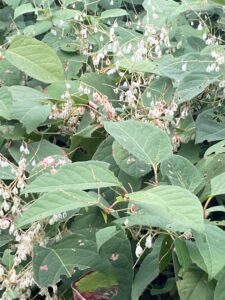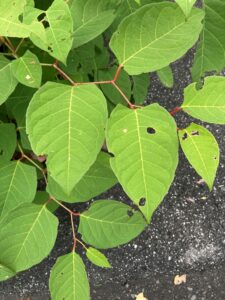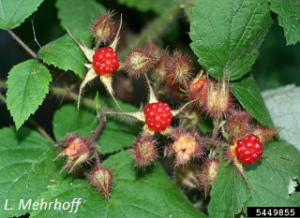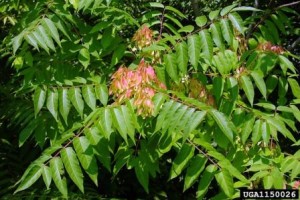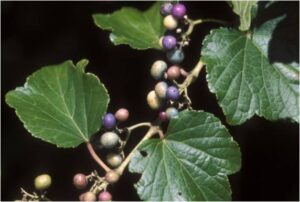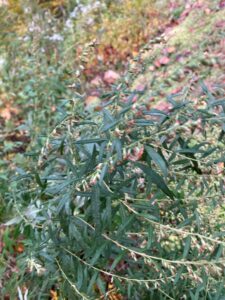Public awareness of invasive plants and the harm they cause is increasing. Homeowners, landscape designers and municipalities alike are requiring the removal of invasive species. It is important to be aware of how to identify these plants, remove effectively and safely, and dispose of the debris properly.
Non-native invasives are aggressive plants that grow unchecked in our growing conditions – and will require repeated efforts to remove. We recommend marking the areas where removal efforts have been taken to make monitoring easier. Plan to replant with more desirable species once the soil is bare.
Removal – The first line of defense is mechanical removal of plant material. For small infestations, plants and roots should be dug up, and all plant material collected and bagged. For larger plants or infestations, cut to ground level and bag the debris. If possible, let the bags sit in a sunny spot for a couple of weeks to solarize the contents, then put in the trash. Many invasive plants can regrow from a small segment, so do not compost. If the infestation continues, chemical controls may be needed, applied by a licensed applicator. For more information on control methods for individual species please visit the “Control Information” page at www.cipwg.uconn.edu. Note: Tangles or thickets of invasives may serve as bird nesting areas, so the best time to remove is late fall/winter.
Japanese Knotweed, Polygonum cuspidatum
HOW TO RECOGNIZE – Mature stems are hollow, stout and green to purple, with prominent joints where leaves emerge from the stem. Leaves are alternate, 3-6” long by 2-4” wide, and are broadly egg-shaped with a flat base and pointed tip. Flowers appear in a showy spray of white clusters in late summer. There may be confusion between knotweed and native pokeweed –key differences are fruit – knotweed doesn’t have any, pokeweed is covered with dark, glossy clusters in late summer, stems – knotweed has purple flecks, and leaves, pokeweed has a narrower, longer leaf.
REMOVAL PROCESS – Dig small plants, removing all shoots, roots and rhizomes. For large infestations, cut plants three times per year for several years. The main root can be six feet underground, so the elimination strategy is to starve the tuber by removing the leaves during periods of high photo-synthesis. Glyphosate can be painted on the leaves (never sprayed) by a licensed applicator during mid- to late-summer.
WHAT TO PLANT INSTEAD – Replace with Eupatorium perfoliatum – Boneset, Cephalanthus occidentalis, Buttonbush, Sambucus canadensis – Elderberry, Salix discolor – Pussy Willow, Lindera benzoin – Spicebush
Wineberry, Rubus phoenicolasius
HOW TO RECOGNIZE – Fruit is bright red when ripe, native berries are black. Three leaflets per leaf versus five for blackberry species. Canes grow to six feet or more in spring, and are covered with fine red hairs. Flowers are very hairy. Blackberries have white, thorny stems.
REMOVAL PROCESS – Remove plants by hand-pulling or use of a spading fork, ideally when the soil is most. All plant segments should be removed and destroyed/disposed of. Mowing or deep cultivation will stimulate sprouting and is discouraged.
WHAT TO PLANT INSTEAD – Replace with native raspberry and blackberry, Viburnum acerifolium -Maple-leaf viburnum, Symphoricarpos x chenaultii ‘Hancock’ – Coralberry.
Tree of Heaven, Ailanthus altissima
HOW TO RECOGNIZE – Large, alternate compound leaves have pointed leaflets with a single notched tooth at the base. Smooth stems with pale gray bark, large clusters of yellow flowers. Unpleasant odor when the leaves, flowers or stems are crushed.
REMOVAL PROCESS – Hand pull young plants when soil is wet, or cut larger plants repeatedly at ground level to exhaust root reserves. Additionally, applying triclopyr to freshly cut stumps to reduce sprouting is also effective, and are best applied by a licensed professional.
WHAT TO PLANT INSTEAD – Replace with Cercis canadensis – Eastern Redbud, Cornus florida – Flowering Dogwood, Amelanchier canadensis – Shadblow, Rhus glabra – Smooth Sumac, or Rhus typhina – Staghorn Sumac
Mile-A-Minute Weed, Persicaria perfoliata
HOW TO RECOGNIZE – Alternate triangle-shaped leaves have barbs on the undersurface. Highly branced, reddish stems are covered with small curved spines. Flowers are small and white, while fruits are deep blue. The vine can grow six inches per day, and will smother other vegetation.
REMOVAL PROCESS – Hand pull plants and roots before fruiting. Repeated mowing or weed-whacking of low growing infestations reduces reserves and prevents or decreases flowering. For extensive infestations, treat with a pre-emergent to kill germinating plants.
WHAT TO PLANT INSTEAD – There are no known native alternatives. Best practice is to encourage growth of the host plants.
Oriental Bittersweet, Celastrus orbiculatus
HOW TO RECOGNIZE – Woody, twining vine, with alternate, nearly round, finely toothed glossy leaves that spiral evenly around the stem. Fruits have a conspicuous yellow casing that opens to reveal a bright red fleshy interior. Roots are orange colored.
REMOVAL PROCESS – Pull small plants including the entire root system. Cut larger vines close to the ground every couple of weeks to prevent resprouting and to deplete the root system. If needed, regrown foliage can be sprayed with triclopyr, or larger stumps can be treated with triclopyr or glyphosate in late summer (licensed applicators only).
WHAT TO PLANT INSTEAD – Replace with Lonicera sempervirens – Trumpet Honeysuckle, Parthenocissus quinquefolia – Virginia Creeper, Clematis virginiana – Virgin’s Bower.
Porcelainberry, Ampelopsis glandulosa var. brevipedunculata
HOW TO RECOGNIZE – Woody branched tendril-bearing vine, heart-shaped leaves have coarse teeth, inconspicuous green to white flowers, loose clusters of fruit in shades of pink, purple and blue.
REMOVAL PROCESS – Hand pull vines in the fall or spring. Cut vines too large to pull out near the ground, and cut regrowth as needed. For dense thickets, cut stems to the ground, allow to re-sprout, then spot-spray with glyphosate.
WHAT TO PLANT INSTEAD – Replace with Wisteria frustescens – American Wisteria, Lonicera sempervirens – Trumpet Honeysuckle, Parthenocissus quinquefolia – Virginia Creeper.
Mugwort, Artemisia vulgaris
HOW TO RECOGNIZE – 2-5’ tall plant, with deeply lobed, pointy-ended leaves. Undersides are light grey-green with silvery hairs. Spike-like clusters of small, greenish-yellow flowers form at the stem terminal. Stems are vertically grooved, and become reddish and woody with maturity.
REMOVAL PROCESS – Mow or cut to the ground every 2-3 weeks for two years. Full shade inhibits germination, so hand cut around nearby vegetation to maintain as much shade cover as possible. Do not pull – the plant can regenerate from any rhizomes left in the soil. Cut before the flowers go to seed, as mugwort can also spread by seed.
WHAT TO PLANT INSTEAD – Replace with Monarda – Bee Balm, Agastache foeniculum – Anise Hyssop, Echinacea purpurea – Purple Coneflower, Eupatorium maculatum – Joe Pye Weed, Asclepias incarnata – Swamp Milkweed.
Garlic Mustard, Alliaria petiolata
HOW TO RECOGNIZE – First year plant is a low-growing rosette of heart-shaped, coarsely-toothed leaves. Second year plant is 1-3’ tall, with alternate, strongly-toothed triangular leaves, and clusters of small, white four-petaled flowers. Smells like garlic.
REMOVAL PROCESS – Hand pull small infestations when soil is moist and before plants have set seed, or cut at ground level when flowering begins.
WHAT TO PLANT INSTEAD – Replace with Phlox subulata – Creeping Phlox, Tiarella cordifolia – Foamflower, Athyrium filix-femina – Lady Fern.
Resources:
https://www.conservect.org/wp-content/uploads/2020/10/Invasives_guide_2020_web.pdf
https://www.inaturalist.org/guide_taxa/882850
https://cipwg.uconn.edu/wp-content/uploads/sites/244/2013/12/NativeLandUseGuide.pdf
https://www.invasive.org/gist/products/handbook/methods-handbook.pdf
https://www.dec.ny.gov/docs/lands_forests_pdf/disposinginvasiveplantfs.pdf
https://blogs.cornell.edu/weedid/japanese-knotweed/

